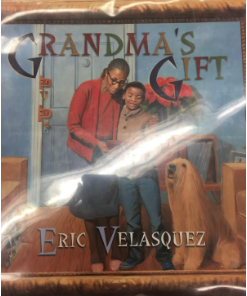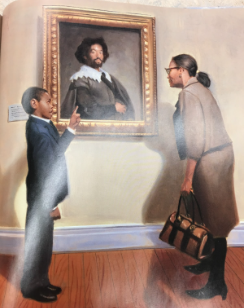Title: Grandma’s Gift
Author & Illustrator: Eric Velasquez
Publisher: Walker Publishing Company, 2010
Number of pages: 29
Tags: Culture, Family, Non-fiction, Holidays, Picture Book, Social Science, Grace Sheley
Genre: Non-fiction
Eric Velasquez’s story centers on his childhood experience of making pasteles with his Grandmother. They travel to various grocery stores to make the pasteles before Christmas Eve dinner. Eric also must make a trip to the Metropolitan Museum of Art for class. While at the Museum, his Grandmother asks for Eric’s translations on almost every painting except one – a painting of Juan de Pareja. Eric fondly recalls that it was this painting and his Grandmother’s gift of a sketchbook that sparked his interested in art.
The text seamlessly incorporates both the Spanish conversations and the English translations – teaching children basic phrases and exposing them to different cultures. The text also provides a sense of community in El Barrio. The Grandmother and shopkeepers know each other and are familiar with her orders. When they are observing Juan de Pareja’s portrait, the text captures the emotions young Eric must have felt that inspired his own art. The ideologies presented in the text reinforce acceptance of cultures, the awareness of challenges faced by those speaking another language, and a sense of community and helping each other.
The illustrations take up both pages almost every page. They use a variety of colors to show the diversity of the New York area and the various cultures that reside there. The process of the pasteles being made is depicted in a picturebook code of multiple illustrations showing movement. These illustrations depict the careful and meticulous process of filling and wrapping the pasteles just right. On the page depicting the Grandmother and Eric observing Juan de Pareja, the page is mostly empty except for the painting and the pair of them. This draws the eye directly to the painting and reinforces the awe that the young boy felt the first time he observed the portrait.
The author’s note at the end recalls the emotions he felt when seeing the portrait for the first time. He discusses the importance of illustrations depicting children of color, as he grew up reading stories that did not reflect his own culture. The portrait of Juan de Pareja reinforced that “my people were part of history and not just a casualty of it.”


